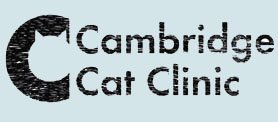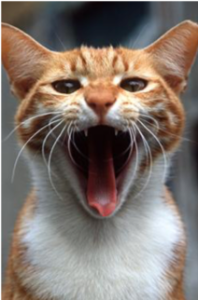 Now that your cat’s teeth are sparkling it is important to begin a dental care regime to prevent them from getting into the same condition again. We understand that this can be difficult, so below are some tricks and information which should help. Continue reading
Now that your cat’s teeth are sparkling it is important to begin a dental care regime to prevent them from getting into the same condition again. We understand that this can be difficult, so below are some tricks and information which should help. Continue reading
Tag Archives: teeth
My cat needs dentistry surgery – but what does that actually involve?
People often worry when their cats are coming in to see us for “a dental”. However, tooth disease is very common as cats get older, and treatment (including surgery) is absolutely necessary to maintain a good quality of life. So, in this blog, we’re going to follow two of our recent patients when they came in for dental care with us!
 9am – These are Mojo and McClane, who are staying with us for the day to have their dentistry surgeries. They are a very bonded pair, so have come in to the clinic on the same day, to keep each other company. Minimising stress in the clinic is in many cases the key to a successful outcome, so we work very hard to keep our patients as happy and relaxed as possible.
9am – These are Mojo and McClane, who are staying with us for the day to have their dentistry surgeries. They are a very bonded pair, so have come in to the clinic on the same day, to keep each other company. Minimising stress in the clinic is in many cases the key to a successful outcome, so we work very hard to keep our patients as happy and relaxed as possible.
The pair have their admission appointment with vet Mini, who discusses the day’s plan with their owner. She then gives the boys a general health check, and performs any necessary pre-surgery procedures, such as blood pressure measurement and blood sample analysis. Mini then places a paper identification collar on the cats’ necks.
At the end of the admission appointment, Mini asks their owners to read through, and sign, their procedure consent forms. We also ask the owners to record emergency contact details for the day, any belongings left with the cats, and any particular food preferences for their dinner once they have recovered from their anaesthesia. We have a cupboard full of tasty and ‘naughty’ delicacies, too!
9:40am – The boys are settled into their hospital accommodation. They have their owner’s old jumper with them, along with lots of lovely soft vet-bedding, to help them feel at ease in unfamiliar surroundings. Cats rely heavily on familiar scents to help them feel comfortable and safe, so a well-used blanket, bed or even piece of old clothing should be brought along on the day.
Our hospital accommodation pods contain removable shelves for cats to climb up onto, or hide behind. We also add in litter trays, water bowls, toys, beds, cardboard boxes and blankets or towels for our patients to hide underneath. The hospital has Feliway (a synthetic copy of the pheromone that cats produce, to help create the feelings of safety and familiarity in their own environments) diffused into the room, as well as sprayed onto bedding. We also spray Pet Remedy onto a small towel or blanket, which many cats find very comforting.
As Mojo and McClane are brothers and very bonded, they are housed in the same accommodation pod for the time before their procedures. After their procedures, they will recover separately, but as soon as they wake up, the boys will be reunited once again.
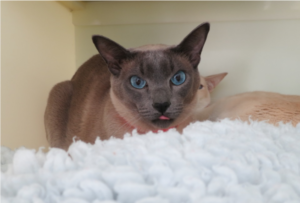 10am – The Tonkinese twosome are now settled into their accommodation, and are relaxing after the initial stress of travelling to the clinic. Cats do not cope well with stress, and it is very important to allow them ample time to settle and calm before their procedures. This pre-procedure time also allows us to monitor the cats’ vital signs (heart rate, respiratory rate and effort, and blood pressure) whilst they are relaxed (stress can massively affect their vitals) and wait for the test results of any blood or urine analysis taken that morning.
10am – The Tonkinese twosome are now settled into their accommodation, and are relaxing after the initial stress of travelling to the clinic. Cats do not cope well with stress, and it is very important to allow them ample time to settle and calm before their procedures. This pre-procedure time also allows us to monitor the cats’ vital signs (heart rate, respiratory rate and effort, and blood pressure) whilst they are relaxed (stress can massively affect their vitals) and wait for the test results of any blood or urine analysis taken that morning.
As you can see, they both chose to cuddle up underneath the shelf, with Mojo using McClane to hide behind!
11:30am – All equipment has been set up, and the anaesthetic protocol for each patient individually planned. We are ready to go!
McClane is the first to have his surgery this morning. McClane is cuddled into a carrier to allow him to be safely moved into our prep room, where he will have his pre-medication (pre-med) injection. We tend not to administer injections to patients whilst they are in their hospital accommodation, as we prefer them to see this room as their safe place, where they can rest and recover, without feeling scared.
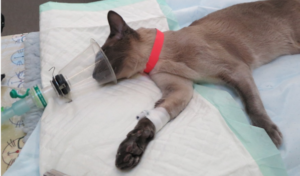 Whilst McClane is cuddled up with a blanket in the carrier, the pre-med is gently administered via injection into a muscle, avoiding any unnecessary handling or struggling. A pre-med usually consists of as many as three drugs mixed together which each provide different analgesic (pain relief) and/or sedative effects. Administering a pre-med allows the patients to relax and become a little sleepy before their anaesthetic. This promotes a smoother induction and recovery from the anaesthetic, provide pre-emptive pain relief (thus reducing the pain a patient feels) and allows pre-anaesthesia procedures to be carried out, such as placement of intravenous catheters and administration of oxygen therapy.
Whilst McClane is cuddled up with a blanket in the carrier, the pre-med is gently administered via injection into a muscle, avoiding any unnecessary handling or struggling. A pre-med usually consists of as many as three drugs mixed together which each provide different analgesic (pain relief) and/or sedative effects. Administering a pre-med allows the patients to relax and become a little sleepy before their anaesthetic. This promotes a smoother induction and recovery from the anaesthetic, provide pre-emptive pain relief (thus reducing the pain a patient feels) and allows pre-anaesthesia procedures to be carried out, such as placement of intravenous catheters and administration of oxygen therapy.
11:45am – After 15-20 minutes, McClane has become a little sleepy, and is happy to be carried to our dentistry table. Whilst he is cuddled up on a warm blanket, an intravenous catheter is placed into a vein in McClane’s front leg. This allows for the administration of anaesthetic drugs, the administration of intravenous fluids, and provides emergency intravenous access.
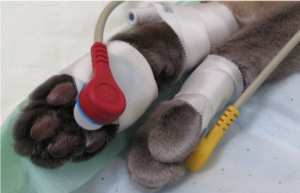
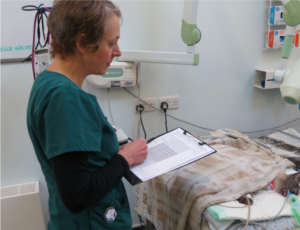 When ready, we then administer an intravenous anaesthetic liquid that puts McClane into a state of unconsciousness. We can then pass the endotracheal tube down his trachea (windpipe) which allows us to administer oxygen and anaesthetic gas.
When ready, we then administer an intravenous anaesthetic liquid that puts McClane into a state of unconsciousness. We can then pass the endotracheal tube down his trachea (windpipe) which allows us to administer oxygen and anaesthetic gas.
He is then hooked up to various monitoring equipment that provides us with information on his:
– Heart rate, rhythm and electrical output (ECG)
– Pulse rate and peripheral capillary oxygen saturation (SpO2)
– Respiratory rate and rhythm
– Carbon dioxide output (capnograph)
– Temperature
– Blood pressure
As well as all of the fancy equipment, McClane is also monitored continuously, and most importantly, by one of our highly trained Registered veterinary Nurses.
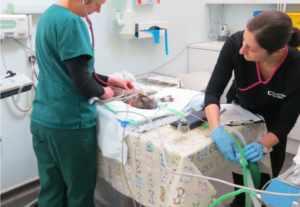 11:50am – To keep him warm throughout his surgery, McClane is laying on top of a Bair Hugger blanket (warm air is circulated through this), and is covered with plastic wrapping (to trap the warm air) and a thick fleece blanket to keep him nice and cosy. Cats can lose body heat very quickly during anaesthesia, so it is essential to try to keep the process as quick as possible, whilst also providing extra heating support.
11:50am – To keep him warm throughout his surgery, McClane is laying on top of a Bair Hugger blanket (warm air is circulated through this), and is covered with plastic wrapping (to trap the warm air) and a thick fleece blanket to keep him nice and cosy. Cats can lose body heat very quickly during anaesthesia, so it is essential to try to keep the process as quick as possible, whilst also providing extra heating support.
We also use several extra pieces of equipment, such as fluid warming devices, and heat and moisture exchange units, which sit on the end of the anaesthetic circuits, to warm and moisten the oxygen that McClane breathes in during his surgery.
McClane is then connected to a syringe driver, which provides carefully calculated measures of intravenous fluid therapy to help maintain his blood pressure throughout the procedure and protect his kidneys. The fluid rate is adjusted throughout the procedure, where necessary.
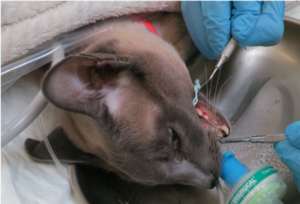 12pm – Once McClane is settled under his anaesthesia, Mini places an absorbent throat pack (cotton wool pad) into the back of his throat, to help absorb any excess fluid, thus further protecting his delicate airways. She then begins to descale his teeth using an ultrasonic descaler. Descaling removes plaque and calculus from above and most importantly below the gum line. A small hand scaler is used to get right under the gum (subgingival). Plaque is the off-white, sticky accumulation on the surface of teeth made up of food particles, bacteria and bacterial products (the furry layer we feel on our teeth in the morning before brushing). Plaque is the main cause of periodontal disease, and turns into Calculus (or tartar/scale) in less than 48 hours after brushing. Calculus can only be removed via descaling, and for several r
12pm – Once McClane is settled under his anaesthesia, Mini places an absorbent throat pack (cotton wool pad) into the back of his throat, to help absorb any excess fluid, thus further protecting his delicate airways. She then begins to descale his teeth using an ultrasonic descaler. Descaling removes plaque and calculus from above and most importantly below the gum line. A small hand scaler is used to get right under the gum (subgingival). Plaque is the off-white, sticky accumulation on the surface of teeth made up of food particles, bacteria and bacterial products (the furry layer we feel on our teeth in the morning before brushing). Plaque is the main cause of periodontal disease, and turns into Calculus (or tartar/scale) in less than 48 hours after brushing. Calculus can only be removed via descaling, and for several r
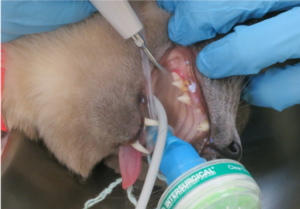
easons, cats have to be anaesthetised for this procedure! The mouth is rinsed with water, and then an antiseptic mouthwash after scaling to reduce bacteria before any surgery.
Descaling is more than a cosmetic procedure: it is very important to remove irritants and debris from the teeth and gums in order to treat reversible or early periodontal disease and gingivitis.
